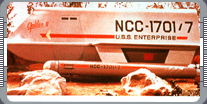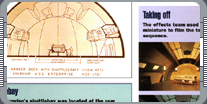
Designing the Galileo Shuttlecraft - By Matt Jefferies.
Halfway through the first season of the original Star Trek series, Captain Kirk's USS Enterprise got a
shuttlecraft and, eventually, a place to put it. Matt Jefferies describes how the Galileo and its shuttlebay
were created.
 The USS Enterprise NCC-1701 shuttlecraft, the
Galileo, wasn't designed at the same time as the rest of the
ship. The reason is simple - shuttlecraft don't get built until a storyline calls for one, because they're just
too expensive. So Jefferies wasn't asked to produce one of these small, short-ranged vessels until 'The Galileo
Seven' was written. "The Enterprise was never suppose to sit on a planet's surface," he says, "so we needed
something other than the transporter room. I think, looking at it in later years, it should probably have been
a shuttle like a city bus, because several times a script came up that called for more people than we had seats
for!"
The USS Enterprise NCC-1701 shuttlecraft, the
Galileo, wasn't designed at the same time as the rest of the
ship. The reason is simple - shuttlecraft don't get built until a storyline calls for one, because they're just
too expensive. So Jefferies wasn't asked to produce one of these small, short-ranged vessels until 'The Galileo
Seven' was written. "The Enterprise was never suppose to sit on a planet's surface," he says, "so we needed
something other than the transporter room. I think, looking at it in later years, it should probably have been
a shuttle like a city bus, because several times a script came up that called for more people than we had seats
for!"
"I worked up sketches for it. But AMT, who were going to build the model in their shops in Phoenix in exchange
 for being able to market the kit of the Enterprise, felt it was beyond their capabilities, so it was designed by
Gene Winfield, an automotive designer who had a custom body shop that primarily serviced the automotive industry
through AMT. The Galileo as everybody knows it today was not my design. Overall I was a little disappointed,
but I think within their capabilities it was a good solution. And it did work, obviously; people did accept it."
for being able to market the kit of the Enterprise, felt it was beyond their capabilities, so it was designed by
Gene Winfield, an automotive designer who had a custom body shop that primarily serviced the automotive industry
through AMT. The Galileo as everybody knows it today was not my design. Overall I was a little disappointed,
but I think within their capabilities it was a good solution. And it did work, obviously; people did accept it."
Jefferies' original design for the shuttle was for a less boxy spacecraft. "Basically it was a teardrop thing,"
he says, "and the whole side panel, the outside door, would slide back, and you could just step right off on the
ground. The seats were like bicycle seats mounted on each side of the keel." AMT duly produced a miniature of
the shuttle. The design did not lend itself to Jefferies bicycle-seat scheme, so he had to come up with an
interior that worked with the exterior shape. "That [the exterior] was a separate set," he says. "A certain
percentage of that had to be done in the studio shops. They brought it all over in a big truck. It was on a
steel frame; it was bulky, and it was heavy. I think if it had been lighter and easier to move, and of course
if we'd had the time or the equipment, we would have probably got much more use out of it. We could have lowered
 it to the surface and had the doors open and the people get out or get in. But it would have taken a lot of
engineering and probably beefing up the stage structure to be able to lower the thing as it was."
it to the surface and had the doors open and the people get out or get in. But it would have taken a lot of
engineering and probably beefing up the stage structure to be able to lower the thing as it was."
The producers used the Galileo miniature for the photography - "I wonder where that model is today," muses
Jefferies - alongside the interior set, which was designed to accommodate the seven personnel the script called
for. It was never specified how many shuttlecraft the Enterprise possessed, but Jefferies assumed there were
several, and gave the Galileo the number '7,' tacked on to the main starship's registration number. The vessel
was 'destroyed' during that episode, but was later seen in other shows - an inconsistency the producers and the
fans have been happy to live with. Jefferies also noticed that within a single script the description of the
shuttle varied. "In one of [writer-producer] Gene Coon's stories ['Metamorphosis'] a description said there
were no doors or opening in evidence, and then once we got inside there four or five entrances and people kept
 coming into the thing. I went to Coon and said, "Mr. Coon, what am I going to do?' He said, 'That's your worry!"
Jefferies also designed a control console, but didn't consider this to be a major item. "We just tried to come
up with something that looked sensible; some intrumentation they would have to have, compared to what could be
done automatically on the Enterprise. Unless you had a story that involved a shuttlecraft entirely then it
would have been such a quick, transitory thing that it would have been wasted effort."
coming into the thing. I went to Coon and said, "Mr. Coon, what am I going to do?' He said, 'That's your worry!"
Jefferies also designed a control console, but didn't consider this to be a major item. "We just tried to come
up with something that looked sensible; some intrumentation they would have to have, compared to what could be
done automatically on the Enterprise. Unless you had a story that involved a shuttlecraft entirely then it
would have been such a quick, transitory thing that it would have been wasted effort."
The Enterprise's shuttlebay was deemed to have room for several shuttles. Jefferies' says, "We had the large
curved clamshell doors at the back, and it didn't look too much different from a lot of today's modern hangers
on the inside. The shuttlebay itself was only in miniature." The view of the shuttlebay in 'Journey to Babel'
was created by shooting through a set of sliding doors toward sections of the interior wall placed eight or 10
feet further back. 'All of our interior walls were of the same finish, which would have included the shuttlebay."
 The Galileo was reincarnated as the Galileo II for 'The Way to Eden' in season three, after the writers had
conceded that the original one no longer existed; the same model was used for photography. Jefferies came up
with a range of other designs for potential shuttles and small vehicles, one of which he labeled the 'space tug.'
"They were just noodling; daydreaming on my part," he says. "But of course the writers were as hard up for ideas
as I was, and sometimes we could spread a seed if they were looking for something different. There's one with
a man sitting in a bubble, and then there was another one with a hook on the back as though it would be for
towing. They'd be service vechicles around a space port or a navy yard kind of thing. We would have been able
to work from the top of the stage on wires and float them or move them around. They would have been fun to do."
The Galileo was reincarnated as the Galileo II for 'The Way to Eden' in season three, after the writers had
conceded that the original one no longer existed; the same model was used for photography. Jefferies came up
with a range of other designs for potential shuttles and small vehicles, one of which he labeled the 'space tug.'
"They were just noodling; daydreaming on my part," he says. "But of course the writers were as hard up for ideas
as I was, and sometimes we could spread a seed if they were looking for something different. There's one with
a man sitting in a bubble, and then there was another one with a hook on the back as though it would be for
towing. They'd be service vechicles around a space port or a navy yard kind of thing. We would have been able
to work from the top of the stage on wires and float them or move them around. They would have been fun to do."
|
|
"DESIGNING THE GALILEO SHUTTLECRAFT" - APRIL 2000 ISSUE 12 STAR TREK: THE MAGAZINE COPYRIGHT OF PARAMOUNT PICTURES.
|